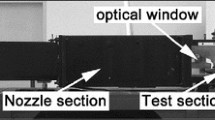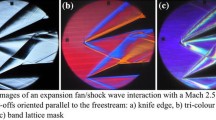Abstract
Innovations in conventional surface and planar laser scattering visualizations revealed complex structures in the Mach 2.5 flow past a sharp-edged, sub-boundary-layer ramp with swept sides that is one type of micro vortex generator (MVG). The incoming flow separated over the leading edge despite the ramp angle being below the threshold for incipient separation. The separation produced a weak trailing horseshoe vortex system. The flow over the top of the MVG separated off the slant edges to produce a large primary vortex pair. Extra details were revealed at the trailing edge with at least two pairs of singularities. Vortex filaments spring from these singularities. Symmetry breaking from the confluence of the two primary vortices was observed as an unsteady wake to result in a train of possibly ring or hairpin vortices trailing downstream.
Graphical Abstract


















Similar content being viewed by others
Notes
Use of fluorescent pigments with ultraviolet light has been reported previously (Merzkirch et al. 1987).
References
Angele KP, Grewe F (2007) Instantaneous behavior of streamwise vortices for turbulent boundary layer separation control. J Fluids Eng 129(2):226–235. doi:10.1115/1.2409327
Babinsky H, Li Y (2009) Microramp control of supersonic oblique shock-wave/boundary-layer interactions. AIAA J 47(3):668–675. doi:10.2514/1.38022
Blinde PL, Humble RA, van Oudheusden BW, Scarano F (2009) Effects of micro-ramps on a shock wave/turbulent boundary layer interaction. Shock Waves 19(6):507–520. doi:10.1007/s00193-009-0231-9
Bur R, Coponet D, Carpels Y (2009) Separation control by vortex generator devices in a transonic channel flow. Shock Waves 19(6):521–530. doi:10.1007/s00193-009-0234-6
Clemens NT, Mungal MG (1991) A planar Mie scattering technique for visualizing supersonic mixing flows. Exp Fluids 11(2–3):175–185. doi:10.1007/BF00190296
Elfstrom GM (1972) Turbulent hypersonic flow at a wedge-compression corner. J Fluid Mech 53(1):113–127. doi:10.1017/S0022112072000060
Herges T, Kroeker E, Elliott G, Dutton C (2010) Microramp flow control of normal shock/boundary-layer interactions. AIAA J 48(11):2529–2542. doi:10.2514/1.52434
Kleine H (2010) Filming the invisible—time-resolved visualization of compressible flows. Euro Phys J Spec Top 182:3–34. doi:10.1140/epjst/e2010-01223-2
Li Q, Liu C (2010) Declining angle effects of the trailing edge of a microramp vortex generator. J Aircr 47(6):2086–2095. doi:10.2514/1.52854
Lim TT (1997) On the role of Kelvin–Helmholtz-like instability in the formation of turbulent vortex rings. Fluid Dyn Res 21(1):47–56. doi:10.1016/S0169-5983(96)00059-7
Lu FK, Li Q, Liu C (2012) Micro vortex generators in high-speed flow. Prog Aerosp Sci 53:30–45. doi:10.1016/j.paerosci.2012.03.003
Lu F K, Pierce A J, Shih Y, Liu C, Li Q (2010) Experimental and numerical study of flow topology past micro-vortex generators. 40th AIAA Fluid Dyn Conf Exhib, Chicago, Illinois, AIAA pp 2010–4463
Merzkirch W (1987) Flow visualization. Academic, Orlando
Pierce AJ, Lu FK (2009) Laser alignment method for portable schlieren system. 39th AIAA Fluid Dyn Conf, San Antonio, Texas, AIAA pp 2009–3574
Pierce A J, Lu F K, Bryant D S, and Shih Y (2010) New developments in surface oil flow visualization. 27th AIAA Aerodyn Meas Ground Test Conf, Chicago, Illinois. AIAA pp 2010–4353
Pierce AJ, Lu FK (2011) New seeding and surface treatment methods for particle image velocimetry. 49th AIAA Aerosp Sci Meet, Orlando, Florida. AIAA pp 2011–1164
Sedney R (1973) A survey of the effects of small protuberances on boundary-layer flows. AIAA J 11(6):782–792. doi:10.2514/3.50520
Settles GS (1986) Modern developments in flow visualization. AIAA J 24(8):1313–1323. doi:10.2514/3.9437
Settles GS, Bogdonoff SM, Vas IE (1976) Incipient separation of a supersonic turbulent boundary layer at high Reynolds numbers. AIAA J 14(1):50–56. doi:10.2514/3.61331
Settles GS, Dolling DS (1986) Swept shock wave–boundary layer interactions. In: Hemsch MJ, Nielsen JN (eds) Tactical missile aerodynamics. AIAA, New York, pp 297–379
Squire LC (1961) The motion of a thin oil sheet under the steady boundary layer on a body. J Fluid Mech 11(2):161–179. doi:10.1017/S0022112061000445
Sun Z, Schrijer FFJ, Scarano F, van Oudheusden BW (2012) The three-dimensional flow organization past a micro-ramp in a supersonic boundary layer. Phys Fluids 24(5):055105. doi:10.1063/1.4711372
Tobak M, Peake DJ (1982) Topology of three-dimensional separated flows. Annu Rev Fluid Mech 14:61–85. doi:10.1146/annurev.fl.14.010182.000425
Wang B, Liu W, Zhao Y, Fan X, Wang C (2012) Experimental investigation of the micro-ramp based shock wave and turbulent boundary layer interaction control. Phys Fluids 24(5):055110. doi:10.1063/1.4719146
Acknowledgments
The author thanks Adam Pierce and Yusi Shih for their assistance with the experiments, and Prof. Chaoqun Liu and Dr. Qin Li for their insightful comments. Support of the research by an AFOSR Grant No. FA9550-08-1-0201 monitored by Dr. John Schmisseur is gratefully acknowledged.
Author information
Authors and Affiliations
Corresponding author
Electronic supplementary material
Below is the link to the electronic supplementary material.
Supplementary material 1 (wmv 5474 KB)
Supplementary material 2 (wmv 8325 KB)
Supplementary material 3 (wmv 8568 KB)
Supplementary material 4 (wmv 18403 KB)
Rights and permissions
About this article
Cite this article
Lu, F.K. Visualization of supersonic flow around a sharp-edged, sub-boundary-layer protuberance. J Vis 18, 619–629 (2015). https://doi.org/10.1007/s12650-014-0272-8
Received:
Revised:
Accepted:
Published:
Issue Date:
DOI: https://doi.org/10.1007/s12650-014-0272-8




